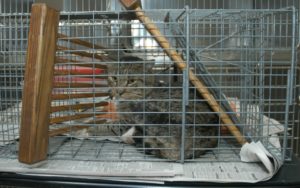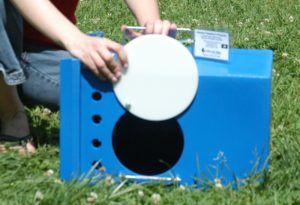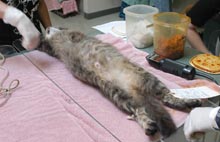Prior to surgery, always sedate a community cat while in the trap. Community cats are unsocialized to humans and should be sedated in the trap for the safety of your staff and the cat.
Make sure you have the appropriate equipment on hand for the safety of your staff and the cats.
-
 Isolator (also known as a trap divider) is a device that looks like a large pick or comb. Insert the isolator into the top of a trap or cage to force the cat into a small portion of the cage for sedation.
Isolator (also known as a trap divider) is a device that looks like a large pick or comb. Insert the isolator into the top of a trap or cage to force the cat into a small portion of the cage for sedation.  A Feral Cat Den (also known as a feral cat handler) is used when you must hold a cat for several days for recovery from an injury or extensive surgery to provide a quiet hiding place. This tool is useful but is not required. The den can be placed in a larger holding pen or large cage where the cat is being held, along with a litter box, food, and water. The cat enters the den by a porthole on the side that you easily slide shut once the cat is inside in order to more safely place food or water or clean the cage. A vertical sliding door makes it easy to transfer the cat to another cage or return the cat to the den for recovery after surgery.
A Feral Cat Den (also known as a feral cat handler) is used when you must hold a cat for several days for recovery from an injury or extensive surgery to provide a quiet hiding place. This tool is useful but is not required. The den can be placed in a larger holding pen or large cage where the cat is being held, along with a litter box, food, and water. The cat enters the den by a porthole on the side that you easily slide shut once the cat is inside in order to more safely place food or water or clean the cage. A vertical sliding door makes it easy to transfer the cat to another cage or return the cat to the den for recovery after surgery. A Spay Board is one tool community cat clinics can use to hold female cats in the proper position during surgery. Though these are not required, they can make surgery quicker. Humane Alliance also offers techniques for holding female cats in place during surgery. Read Alley Cat Allies’ spay board design instructions to build your own. Other equipment to have on hand:
A Spay Board is one tool community cat clinics can use to hold female cats in the proper position during surgery. Though these are not required, they can make surgery quicker. Humane Alliance also offers techniques for holding female cats in place during surgery. Read Alley Cat Allies’ spay board design instructions to build your own. Other equipment to have on hand:
- Safety gloves
- Newspapers (to replace soiled newspapers in traps while cats are in surgery)
- Cleaning solution in spray bottles (a diluted bleach mixture works well)
- Clippers
- Additional clean towels or sheets to cover traps
This equipment can be purchased from the following companies and distributors:
Listing these companies here does not in any way imply an endorsement by Alley Cat Allies, nor is Alley Cat Allies responsible for the content of the websites or the utility of the equipment.
Tru-Catch Traps:
Tru-Catch Trap/Manufacturing Systems, Inc.
300 Industrial St. PO Box 816
Belle Fourche, SD 57717-0816
Phone: 800.247.6132 or 650.892.2717
Website: www.trucatchtraps.comTomahawk Traps:
Tomahawk Live Trap Co.
P.O. Box 325
Tomahawk, Wisconsin 54487
Phone: 800.272.8727 or 715.453.3550
Fax: 715.453.4326
Website: www.Livetrap.comAnimal Care Equipment & Services, Inc. (ACES)
3075 75th Street #2
Boulder, CO 80301
Phone: 303-296-9287 (Worldwide) or 800-338-2237 (North America)
Fax: 303-298-8894
Website: http://www.animal-care.com/
Email: [email protected]
- Plan your surgery tracking system in advance. When multiple cats are visiting your practice or clinic at one time, it is important to have a tracking system in placesuch as matching tags that attach to the trap and the cat’s legthat will ensure cats are returned to the appropriate trap. Since feral cat traps are marked with their trap location so that cats can be returned to the exact place they were trapped, this can not be overlooked. That same tag can be used to track the cat through various clinic stations and to note the services and medications she received.
- Prepare for vaccinations and other medical care. Rabies vaccines should be administered as mandated by state regulations. Alley Cat Allies encourages using the three-year vaccine for adult community cats. Other vaccinations, such as distemper, and other treatments, such as for fleas or worms, can be administered at the discretion of the veterinarian and based on the caregiver’s ability to pay. We encourage veterinarians to consult industry best practices. For more hands-on information visit the Feral Cat Project and Humane Alliance.
